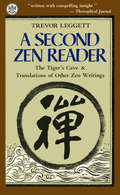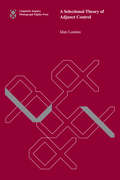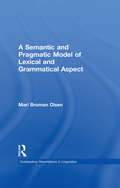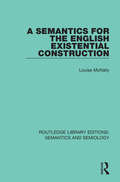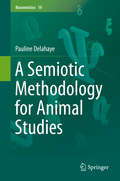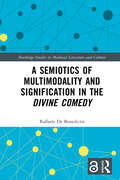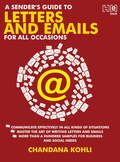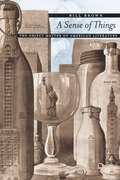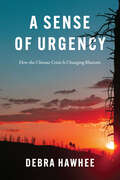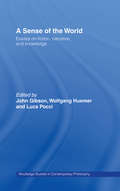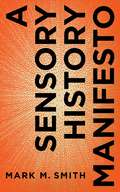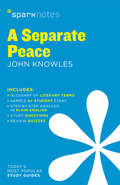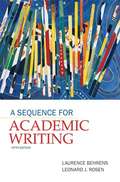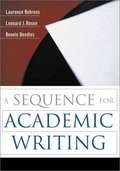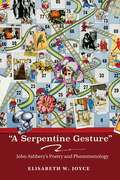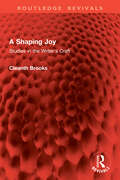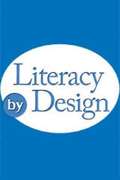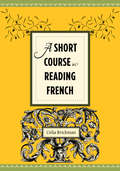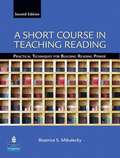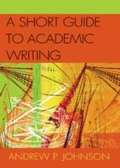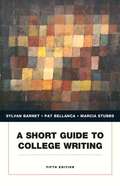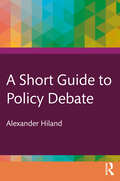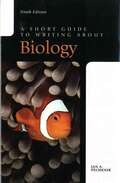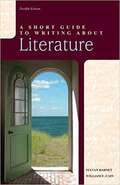- Table View
- List View
A Second Zen Reader: The Tiger's Cave & Translations of Other Zen Writings
by Trevor LeggettWhat happens when a young Zen monk makes a terrible mistake at a public ceremony? What sort of reception does a well-known abbot get today when he visits his old teacher? The answers to these questions can be found in this fascinating translation of Japanese Zen texts by Trevor Leggett. From historical incidents to classes Zen commentaries, this is an account of actual Zen lifeâ "the life of traditional temple trainingâ "and a valuable guide to the meaning of Zen in Japan.
A Selectional Theory of Adjunct Control (Linguistic Inquiry Monographs)
by Idan LandauA novel, systematic theory of adjunct control, explaining how and why adjuncts shift between obligatory and nonobligatory control.Control in adjuncts involves a complex interaction of syntax, semantics, and pragmatics, which so far has resisted systematic analysis. In this book, Idan Landau offers the first comprehensive account of adjunct control. Extending the framework developed in his earlier book, A Two-Tiered Theory of Control, Landau analyzes ten different types of adjuncts and shows that they fall into two categories: those displaying strict obligatory control (OC) and those alternating between OC and nonobligatory control (NOC). He explains how and why adjuncts shift between OC and NOC, unifying their syntactic, semantic, and pragmatic properties. Landau shows that the split between the two types of adjuncts reflects a fundamental distinction in the semantic type of the adjunct: property (OC) or proposition (NOC), a distinction independently detectable by the adjunct's tolerance to a lexical subject. After presenting a fully compositional account of controlled adjuncts, Landau tests and confirms the specific configurational predictions for each type of adjunct. He describes the interplay between OC and NOC in terms of general principles of competition--both within the grammar and outside of it, in the pragmatics and in the processing module--shedding new light on classical puzzles in the acquisition of adjunct control by children. Along the way, he addresses a range of empirical phenomena, including implicit arguments, event control, logophoricity, and topicality.
A Semantic and Pragmatic Model of Lexical and Grammatical Aspect (Outstanding Dissertations in Linguistics)
by Mari B. OlsenFirst Published in 1997. This work studies two related phenomena in human language: the ability of verbs and other lexical items to describe how a situation (event or state) develops or holds in time (LEXICAL ASPECT) and the view some verbal auxiliaries and affixes present of the development or result of a situation at a given time (GRAMMATICAL ASPECT). Through this investigation the author seeks to reveal a formal situation structure represented by aspectual phenomena, a structure to which other linguistic elements make reference, particularly tense. This structure describes the semantics of aspect and provides a principled input to pragmatic aspectual interpretation.
A Semantics for the English Existential Construction (Routledge Library Editions: Semantics and Semiology #9)
by Louise McNallyFirst published in 1997, this book addresses the question: What is the interpretation of English there-existential construction? One of the principal goals is to develop an interpretation for the construction that will specifically address other properties of the postcopular DP. After outlining the problem, the author goes on to present a syntactic motivation for the claim that the postcopular DP is the sole complement to the existential predicate, as well as for the claim that the optional final phrase is a predictive adjunct. In chapter 3 the interpretation for the basic existential construction is developed and then compared to analyses that take the postcopular DP to denote an ordinary individual or a generalised quantifier of individuals. This analysis is then augmented to account for the contribution of the final XP and shows how the predicate restriction can be derived from a more general condition on depictive/circumstantial VP-adjuncts. The final chapter contain some speculative discussion of the broader implications of the proposal in the context of data such as "list" existential and "presentational-there" sentences.
A Semiotic Methodology for Animal Studies (Biosemiotics #19)
by Pauline DelahayeThis monograph is about new perspective in animal studies methodology, by using concepts and tools from the field of semiotics. It proposes a reflexion on current challenges and issues in the ethology field, and introduces different semiotics – biosemiotics, zoosemiotics – as potential methodological solutions. The chapters cover many aspects of ethology where semiotics can be a helpful hand: studies of language, culture, cognition or emotions, issues about complex, endangered or variable species. It explains why these points are difficult to study for actual ethology, why they still matter for researchers, biodiversity actors or wildlife programs, and how an interdisciplinary study with a semiotic point of view can help understand them. This book will appeal to a wide readership, from researchers and academics in living sciences as well as in linguistics fields, to other professionals – veterinarian, wildlife managers, zookeepers, and many others – who feel the need to better understand some aspects of animals they are working with. Students with animal focus should read this book as an introduction to interdisciplinary methodology, and a proposition to work differently with animals.
A Semiotics of Multimodality and Signification in the Divine Comedy (Routledge Studies In Medieval Literature And Culture Ser.)
by Raffaele De BenedictisA new critical method for the Divine Comedy which focuses not only on language-as-writing but also and equally on other discursive modes that the Divine Comedy authorizes. Multimodality was already present in Dante’s time, and the reception of the Divine Comedy took place multimodally. Thus, a theoretical study of multimodality carried out under the semiotic lens sheds light on how and why a mode is more effective than another and/or how they may combine in producing signification and new ontologies warranted by Dante’s text. Also, we do not yet have a critical theory that allows us to understand the function of multimodality for the creation of new forms of signification and of clarifying the ontological boundaries set forth by different modalities. It is a new and original study which contributes to the advancement of Dante Studies, Literary Criticism (with a focus on literary semiotics), Multimedia/Multiliteracy, philosophy of language, communication, and education. Chapters 1, 2, and 5 of this book are freely available as a downloadable Open Access PDF at http://www.taylorfrancis.com under a Creative Commons Attribution-Non Commercial-No Derivatives (CC-BY-NC-ND) 4.0 license. .
A Senders Guide to Letters and Emails
by Chandana KohliWondering how to word a key official letter? Searching for the right way to write an email to an important client? Thinking about how to convey what you want on an important occasion? Your business and personal communication letter and email guide is here. In today?s world, where a lot depends on the quality of your communication, how you approach it is more important than it has ever been. Daily communication happens, more often than not, without a personal interface, and this makes the letter or email an extremely important tool to convey your personality, skills and ideas effectively and succinctly. Despite changes in the medium and the form, the letter continues to be the driving force of all kinds of communication, official or personal. This book will help you communicate more cogently and confidently, and guide you through situations where you might find it difficult to communicate in writing. Learn how to write suitable emails and letters for official needs and challenging social situations. Choose from over a hundred templates and tips. Find ready-made letters for all your business and personal needs. This book will make letter writing faster, easier and, above all, perfectly suited to the situation and occasion.
A Sense of Things: The Object Matter of American Literature
by Bill BrownIn May 1906, the Atlantic Monthly commented that Americans live not merely in an age of things, but under the tyranny of them, and that in our relentless effort to sell, purchase, and accumulate things, we do not possess them as much as they possess us. For Bill Brown, the tale of that possession is something stranger than the history of a culture of consumption. It is the story of Americans using things to think about themselves. Brown's captivating new study explores the roots of modern America's fascination with things and the problem that objects posed for American literature at the turn of the century. This was an era when the invention, production, distribution, and consumption of things suddenly came to define a national culture. Brown shows how crucial novels of the time made things not a solution to problems, but problems in their own right. Writers such as Mark Twain, Frank Norris, Sarah Orne Jewett, and Henry James ask why and how we use objects to make meaning, to make or remake ourselves, to organize our anxieties and affections, to sublimate our fears, and to shape our wildest dreams. Offering a remarkably new way to think about materialism, A Sense of Things will be essential reading for anyone interested in American literature and culture.
A Sense of Urgency: How the Climate Crisis Is Changing Rhetoric
by Debra HawheeA study of how the climate crisis is changing human communication from a celebrated rhetorician. Why is it difficult to talk about climate change? Debra Hawhee argues that contemporary rhetoric relies on classical assumptions about humanity and history that cannot conceive of the present crisis. How do we talk about an unprecedented future or represent planetary interests without privileging our own species? A Sense of Urgency explores four emerging answers, their sheer novelty a record of both the devastation and possible futures of climate change. In developing the arts of magnitude, presence, witness, and feeling, A Sense of Urgency invites us to imagine new ways of thinking with our imperiled planet.
A Sense of the World: Essays on Fiction, Narrative, and Knowledge (Routledge Studies in Contemporary Philosophy)
by John Gibson Wolfgang Huemer Luca PocciA team of leading contributors from both philosophical and literary backgrounds have been brought together in this impressive book to examine how works of literary fiction can be a source of knowledge. Together, they analyze the important trends in this current popular debate. The innovative feature of this volume is that it mixes work by literary theorists and scholars with work of analytic philosophers that combined together provide a comprehensive statement of the variety of ways in which works of fiction can engage questions of worldly interest. It uses the problem of cognitive value to explore: literature’s contribution to ethical life literature’s ability to engage in social and political critique the role narrative plays in opening up possibilities of moral, aesthetic, experience and selfhood This remarkable volume will attract the attention of both literature and philosophy scholars with its statement of the various ways that literature and life take an interest in one another.
A Sensory History Manifesto (Perspectives on Sensory History #4)
by Mark M. SmithA Sensory History Manifesto is a brief and timely meditation on the state of the field. It invites historians who are unfamiliar with sensory history to adopt some of its insights and practices, and it urges current practitioners to think in new ways about writing histories of the senses.Starting from the premise that the sensorium is a historical formation, Mark M. Smith traces the origins of historical work on the senses long before the emergence of the field now called "sensory history," interrogating, exploring, and in some cases recovering pioneering work on the topic. Smith argues that we are at an important moment in the writing of the history of the senses, and he explains the potential that this field holds for the study of history generally. In addition to highlighting the strengths of current work in sensory history, Smith also identifies some of its shortcomings. If sensory history provides historians of all persuasions, times, and places a useful and incisive way to write about the past, it also challenges current practitioners to think more carefully about the historicity of the senses and the desirability—even the urgency—of engaged and sustained debate among themselves. In this way, A Sensory History Manifesto invites scholars to think about how their field needs to evolve if the real interpretive dividends of sensory history are to be realized.Concise and convincing, A Sensory History Manifesto is a must-read for historians of all specializations.
A Sensory History Manifesto (Perspectives on Sensory History)
by Mark M. SmithA Sensory History Manifesto is a brief and timely meditation on the state of the field. It invites historians who are unfamiliar with sensory history to adopt some of its insights and practices, and it urges current practitioners to think in new ways about writing histories of the senses.Starting from the premise that the sensorium is a historical formation, Mark M. Smith traces the origins of historical work on the senses long before the emergence of the field now called “sensory history,” interrogating, exploring, and in some cases recovering pioneering work on the topic. Smith argues that we are at an important moment in the writing of the history of the senses, and he explains the potential that this field holds for the study of history generally. In addition to highlighting the strengths of current work in sensory history, Smith also identifies some of its shortcomings. If sensory history provides historians of all persuasions, times, and places a useful and incisive way to write about the past, it also challenges current practitioners to think more carefully about the historicity of the senses and the desirability—even the urgency—of engaged and sustained debate among themselves. In this way, A Sensory History Manifesto invites scholars to think about how their field needs to evolve if the real interpretive dividends of sensory history are to be realized.Concise and convincing, A Sensory History Manifesto is a must-read for historians of all specializations.
A Separate Peace SparkNotes Literature Guide (SparkNotes Literature Guide Series)
by SparkNotesA Separate Peace SparkNotes Literature Guide by John Knowles Making the reading experience fun! When a paper is due, and dreaded exams loom, here's the lit-crit help students need to succeed! SparkNotes Literature Guides make studying smarter, better, and faster. They provide chapter-by-chapter analysis; explanations of key themes, motifs, and symbols; a review quiz; and essay topics. Lively and accessible, SparkNotes is perfect for late-night studying and paper writing. Includes:An A+ Essay—an actual literary essay written about the Spark-ed book—to show students how a paper should be written.16 pages devoted to writing a literary essay including: a glossary of literary termsStep-by-step tutoring on how to write a literary essayA feature on how not to plagiarize
A Sequence For Academic Writing
by Laurence Behrens Leonard J. RosenBuilding off of the hallmark writing instruction of the best-selling Writing and Reading Across the Curriculum, this writing guide focuses on the critical reading and writing strategies that students need in order to thoughtfully interpret and incorporate source material into their own papers. The text employs high-interest readings from a range of disciplines to allow students to practice these strategies and skills, while numerous student papers model the kinds of academic texts that students are expected to produce.
A Sequence for Academic Writing
by Laurence Behrens Leonard J. Rosen Bonnie BeedlesBased on the best-selling Writing and Reading Across the Curriculum, this primer for academic writing focuses on broad rhetorical strategies - summary, critique, synthesis, and analysis - that will aid in academic success whatever the discipline. The authors' focus on and coverage of the four academic writing strategies has garnished outstanding praise from reviewers. Their thorough coverage of the writing process and critical reading is found throughout the book. This coverage includes sample academic documents and essays, annotated "drafts" used to model the development of these key writing strategies, and coverage of research and documentation that includes discussion of research strategies, writing up research, and documentation styles. Finally, the authors have combined timely, compelling, and challenging readings with writing exercises and chapter summaries to make this book both engaging and easy to learn from. For those interested in becoming proficient in academic writing.
A Serpentine Gesture: John Ashbery's Poetry and Phenomenology (Recencies Series: Research and Recovery in Twentieth-Century American Poetics)
by Elisabeth W. JoyceIn &“A Serpentine Gesture&”: John Ashbery&’s Poetry and Phenomenology Elisabeth W. Joyce examines John Ashbery&’s poetry through the lens of Maurice Merleau-Ponty&’s conception of phenomenology. For Merleau-Ponty, perception is a process through which people reach outside of themselves for sensory information, map that experiential information against what they have previously encountered and what is culturally inculcated in them, and articulate shifts in their internal repositories through encounters with new material. Joyce argues that this process reflects Ashbery&’s classic statement of poetry being the &“experience of experience.&” Through incisive close readings of Ashbery&’s poems, Joyce examines how he explores this process of continual reverberation between what is sensed and what is considered about that sensation and, ultimately, how he renders these perceptions into the &“serpentine gesture&” of language.
A Shaping Joy: Studies in the Writer's Craft (Routledge Revivals)
by Cleanth BrooksIn A Shaping Joy (originally published in 1971), Cleanth Brooks writes about modern literature and the criticism that has been developed to deal with it. Most of the essays concern poets and novelists of the twentieth century, but there are also discussions of nineteenth-century American writers such as Mark Twain and Edgar Allen Poe, and of traditional English poets such as Wordsworth, Milton, and Marlowe.Among the functions of literature described in the first essay are those of nourishing the imagination and keeping the language alive and the channels of communication open. The criticism contained in the essays that follow admirably exemplifies these concerns. Whether writing on the world of William Faulkner and the literature of the American South, or on subjects more familiar to the British reader—Joyce, Auden, and T.S. Eliot, for example—Professor Brooks keeps the methods of communication marvelously unblocked. It is criticism of the rarest kind—alert, imaginative and wholly invigorating.This book will be a beneficial read for students and researchers of English literature, particularly of literary criticism.
A Ship Is Coming! (Rigby Literacy by Design)
by Bradley Clark Dennis Fertig Cynthia ClarkNIMAC-sourced textbook
A Short Course in Reading French
by Celia BrickmanThis textbook teaches the basics of French grammar, reinforcing its lessons with exercises and key practice translations. A systematic guide, the volume is a critical companion for university-level students learning to read and translate written French into English; for graduate scholars learning to do research in French or prepping for proficiency exams; and for any interested readers who want to improve their facility with the French language. In addition, A Short Course in Reading French exposes readers to a broad range of French texts from the humanities and social sciences, including writings by distinguished francophone authors from around the world. The book begins with French pronunciation and cognates and moves through nouns, articles, and prepositions; verbs, adjectives, and adverbs; a graduated presentation of all the indicative and subjunctive tenses; object, relative, and other pronouns; the passive voice; common idiomatic constructions; and other fundamental building blocks of the French language. Chapters contain translation passages from such authors as Pascal, Montesquieu, Proust, Sartre, Bourdieu, Senghor, Césaire, de Certeau, de Beauvoir, Barthes, and Kristeva. Drawn from more than two decades of experience teaching French to students from academic and nonacademic backgrounds, Celia Brickman's clear, accessible, and time-tested format enables even beginners to develop a sophisticated grasp of the language and become adept readers of French.There is an answer key for translation exercises and for non-copyrighted translation passages available to professors and teachers who have assigned this title in a class. Please provide your name, title, institution, and number of students in the course in an email to coursematerials@columbiauniversitypress.com.
A Short Course in Teaching Reading: Practical Techniques for Building Reading Power, Second Edition
by Beatrice S. MikuleckyThis revision of the classical practical handbook A Short Course in Teaching Reading Skills combines reading theory with practical classroom application. An invaluable resource to the reading teacher, teacher-in-training, or administrator who wants to stress quality reading comprehension instruction, the principles apply to teenage through adult learners who already have basic decoding skills.
A Short Guide to Academic Writing
by Andrew P. JohnsonA Short Guide to Academic Writing de-mystifies the process of writing and describes everything that is needed to write in an academic and professional style.
A Short Guide to College Writing (Fifth Edition)
by Sylvan Barnet Pat Bellanca Marcia StubbsThis book offers students practical advice on writing successful college essays from the beginning of the process to the end. Students can use for advice about matters large and small--about choosing a topic, developing a thesis, constructing a paragraph, documenting a source, using a semicolon. The instructor can suggest chapters or passages that the student should consult in generating ideas, revising a draft, editing a revision, or preparing final copy.
A Short Guide to Policy Debate
by Alexander HilandThis short, practical guide to policy debate helps coaches, instructors, and students prepare for competitions at the collegiate level.This book offers step-by-step guidance on how to prepare and analyze topics, cases, and rebuttals and outlines the norms and rules of contemporary interscholastic competition in the United States. It provides a structured and systematic approach to preparation to improve the educational and competitive elements of the debate experience. Written in an accessible style, this book explains how to conduct research and compete online, the strategies behind constructing a case, and includes guidance on how to determine judge tendencies. Chapters include glossaries, sample cases and speeches, and practical activities to allow readers to develop their argumentation and cross-examination skills.Providing a streamlined, student-focused approach to policy debate, this book will be of interest to students and instructors in the fields of debate, persuasion, public speaking, and argumentation.
A Short Guide to Writing About Biology
by Jan PechenikThis best-selling writing guide teaches students to think as biologists and to express ideas clearly and concisely through their writing.
A Short Guide to Writing About Literature
by Sylvan Barnet William CainPart of Longman's successful Short Guide Series, A Short Guide to Writing about Literature emphasizes writing as a process and incorporates new critical approaches to writing about literature. <p><p>The twelfth edition continues to offer students sound advice on how to become critical thinkers and enrich their reading response through accessible, step-by-step instruction.
